seats GMC SIERRA DENALI 2003 Owners Manual
[x] Cancel search | Manufacturer: GMC, Model Year: 2003, Model line: SIERRA DENALI, Model: GMC SIERRA DENALI 2003Pages: 428, PDF Size: 20.35 MB
Page 2 of 428
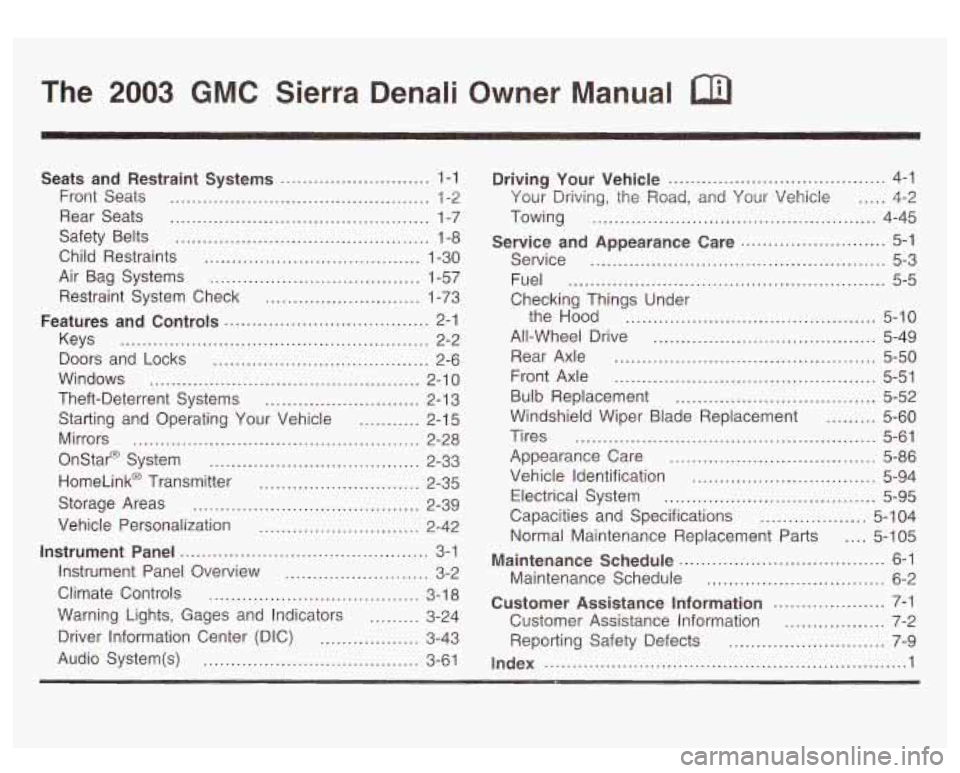
The 2003 GMC Sierra Denali Owner Manual a
Seats and Restraint Systems ........................... 1-1
Front Seats ............................................... 1-2
Rear Seats
............................................... 1-7
Safety Belts
.............................................. 1-8
Child Restraints
....................................... 1-30
Air Bag Systems
...................................... 1-57
Restraint System Check
............................ 1-73
Features and Controls
..................................... 2-1
Keys
........................................................ 2-2
Doors and Locks
....................................... 2-6
Windows
................................................. 2-1 0
Theft-Deterrent Systems ............................ 2-1 3
Starting and Operating Your Vehicle ........... 2-15
Mirrors
.................................................... 2-28
Onstar@ System
...................................... 2-33
HomeLink@ Transmitter
............................. 2-35
Storage Areas
......................................... 2-39
Instrument Panel
............................................. 3-1
Vehicle
Personalization
............................. 2-42
Instrument Panel Overview
.......................... 3-2
Climate Controls
...................................... 3-1 8
Warning Lights, Gages and Indicators
......... 3-24
Driver Information Center (DIC)
.................. 3-43
Audio System(s)
....................................... 3-61 Driving Your Vehicle
....................................... 4-1
Your
Driving, the Road, and Your Vehicle ..... 4-2
Towing
................................................... 4-45
Service and Appearance Care
.......................... 5-1
Service
..................................................... 5-3
Fuel
......................................................... 5-5
Checking Things Under the Hood
............................................. 5-10
All-Wheel Drive
........................................ 5-49
Rear Axle
............................................... 5-50
Front Axle
............................................... 5-51
Bulb Replacement
.................................... 5-52
Windshield Wiper Blade Replacement
......... 5-60
Tires
...................................................... 5-61
Appearance Care
..................................... 5-86
Vehicle Identification
................................. 5-94
Electrical System
...................................... 5-95
Capacities and Specifications
................... 5-1 04
Normal Maintenance Replacement Parts
.... 5-1 05
Maintenance Schedule
..................................... 6-1
Maintenance Schedule
................................ 6-2
Customer Assistance Information
.................... 7-1
Customer Assistance Information
.................. 7-2
Reporting Safety Defects
............................ 7-9
Index
................................................................. 1
Page 5 of 428
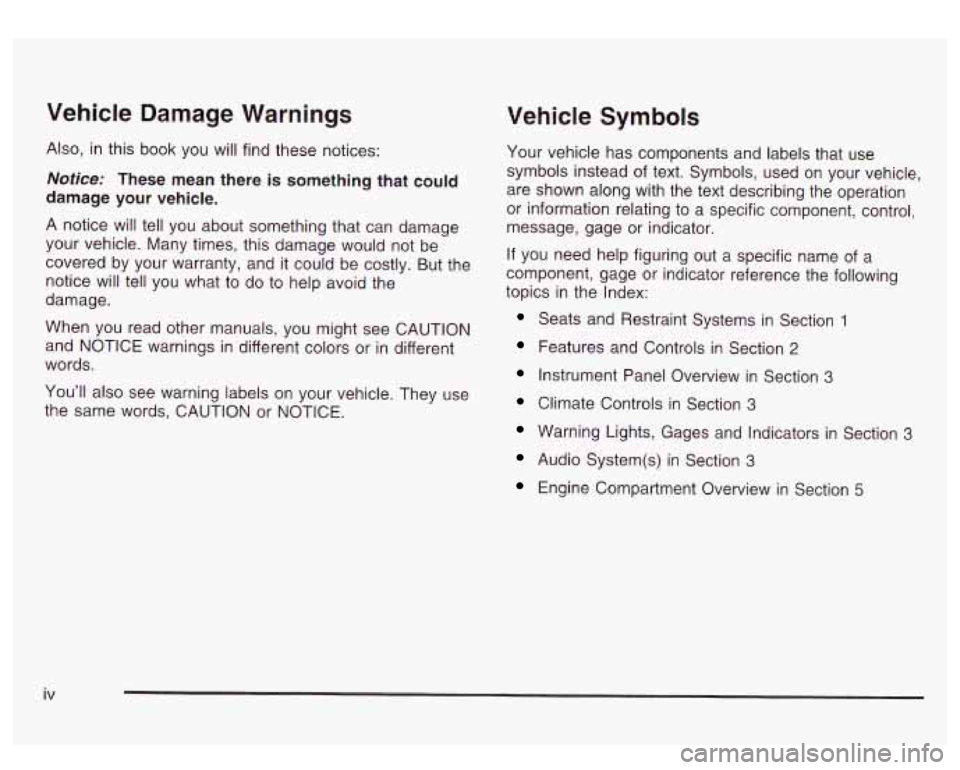
Vehicle Damage Warnings
Also, in this book you will find these notices:
Notice: These mean there is something that could
damage
your vehicle.
A notice will tell you about something that can damage
your vehicle. Many times, this damage would not be
covered by your warranty, and it could be costly. But the
notice will tell you what to do to help avoid the
damage.
When you read other manuals, you might see CAUTION
and NOTICE warnings in different colors or
in different
words.
You’ll also see warning labels on your vehicle. They use
the same words, CAUTION or NOTICE.
Vehicle Symbols
Your vehicle has components and labels that use
symbols instead
of text. Symbols, used on your vehicle,
are shown along with the text describing the operation
or information relating to a specific component, control,
message, gage or indicator.
If you need help figuring out a specific name of a
component, gage or indicator reference the following
topics in the Index:
Seats and Restraint Systems in Section 1
Features and Controls in Section 2
Instrument Panel Overview in Section 3
Climate Controls in Section 3
Warning Lights, Gages and Indicators in Section 3
Audio System(s) in Section 3
Engine Compartment Overview in Section 5
iv
Page 8 of 428
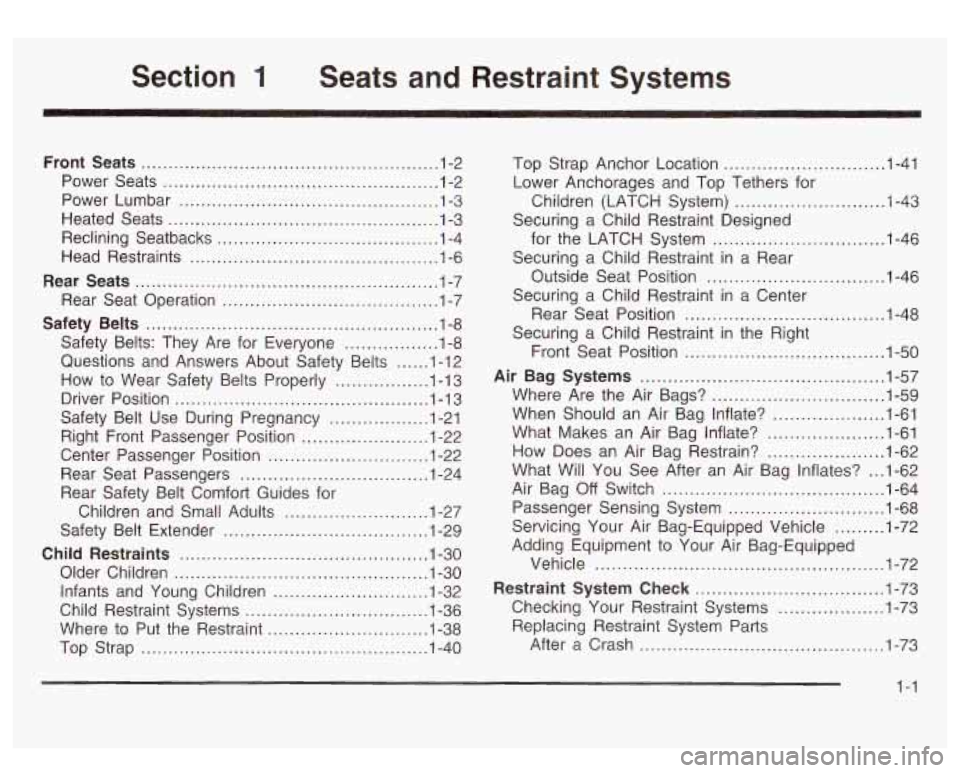
Section Seats and Restraint Systems
Front Seats ..................................................... .l -2
Power Seats ............................. .............. 1-2
Power Lumbar ............................................... 1-3
Heated Seats
................................................. 1-3
Reclining Seatbacks
........................................ 1-4
Head Restraints
............................................. 1-6
Rear Seats
....................................................... 1 -7
Rear Seat Operation
....................................... 1-7
Safety Belts
..................................................... 1-8
Questions and Answers About Safety Belts
...... 1-1 2
How to Wear Safety Belts Properly
................. 1-13
Driver Position
.............................................. 1.1 3
Safety Belt Use During Pregnancy
.................. 1-21
Right Front Passenger Position
....................... 1-22
Safety Belts: They
Are for Everyone
................. 1-8
Center Passenger Position
............. ..... 1-22
Rear Seat Passengers
...................... ..... 1-24
Rear Safety Belt Comfort Guides for Children and Small Adults
.......................... 1-27
Safety Belt Extender
......................... ..... 1-29
Child Restraints
............................. ..... 1-30
Older Children
.............................................. 1-30
Infants and Young Children ............................ 1-32
Child Restraint Systems
................................ -1-36
Where to Put the Restraint
............................. 1-38
Top Strap
................................................... .l -40
Top Strap Anchor Location ............................. 1.41
Children (LATCH System)
....................... 1-43
for the LATCH System
............................... 1-46
Outside Seat Position
................................ 1-46
Rear Seat Position
.................................... 1-48
Front Seat Position
.................................... 1-50
Air Bag Systems ....................... .............. 1-57
Where Are the Air Bags?
............................ 1-59
When Should an Air Bag Inflate? .................... 1-61
What Makes an Air Bag Inflate?
..................... 1-61
Lower Anchorages and Top
Tethers for
Securing a Child Restraint Designed
Securing a Child Restraint in a Rear
Securing a Child Restraint in a Center
Securing a Child Restraint
in the Right
How Does an Air Bag Restrain?
..................... 1-62
What Will You See After an Air Bag Inflates?
... 1-62
Air Bag
Off Switch ........................................ 1-64
Passenger Sensing System
............................ 1-68
Servicing Your Air Bag-Equipped Vehicle
......... 1-72
Adding Equipment to Your Air Bag-Equipped
Vehicle
.................................................... 1-72
Restraint System Check
.................................. 1-73
Checking Your Restraint Systems ................... 1-73
Replacing Restraint System Parts
After a Crash
.............................. ...... .l -73
1-1
Page 9 of 428
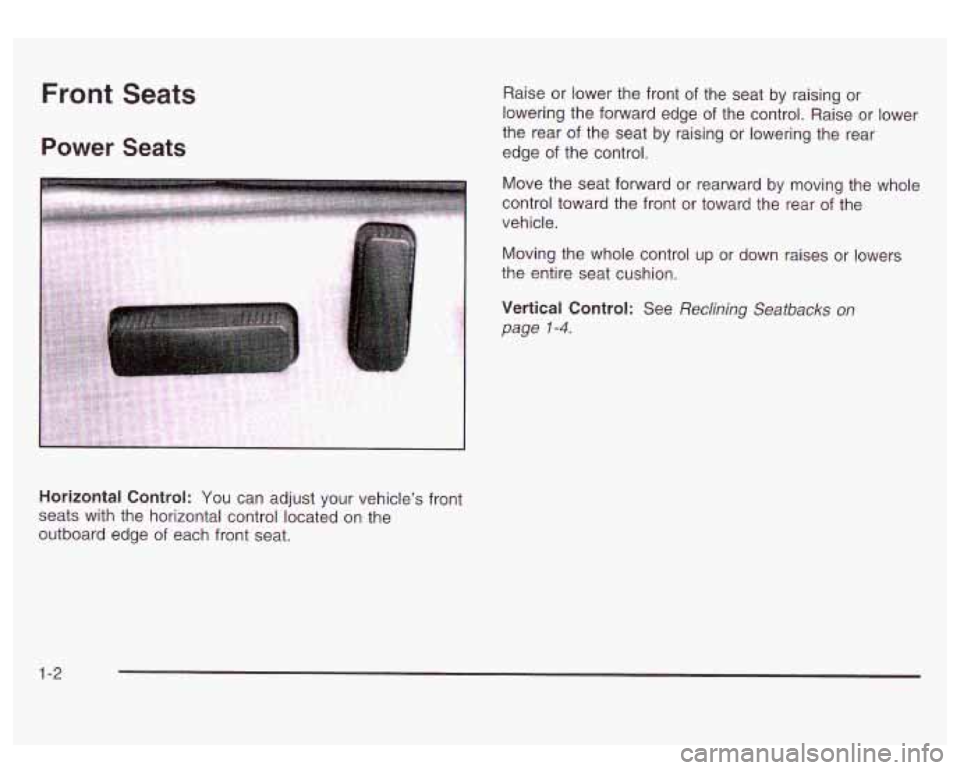
Front Seats
Power Seats
Raise or lower the front of the seat by raising or
lowering the forward edge of the control. Raise or lower
the rear of the seat by raising or lowering the rear
edge of the control.
Move the seat forward or rearward by moving the whole
control toward the front or toward the rear
of the
vehicle.
Moving the whole control up or down raises or lowers
the entire seat cushion.
Vertical Control: See
Reclining Seatbacks on
page
1-4.
Horizontal Control: You can adjust your vehicle’s front
seats with the horizontal control located on the
outboard edge
of each front seat.
1-2
Page 10 of 428
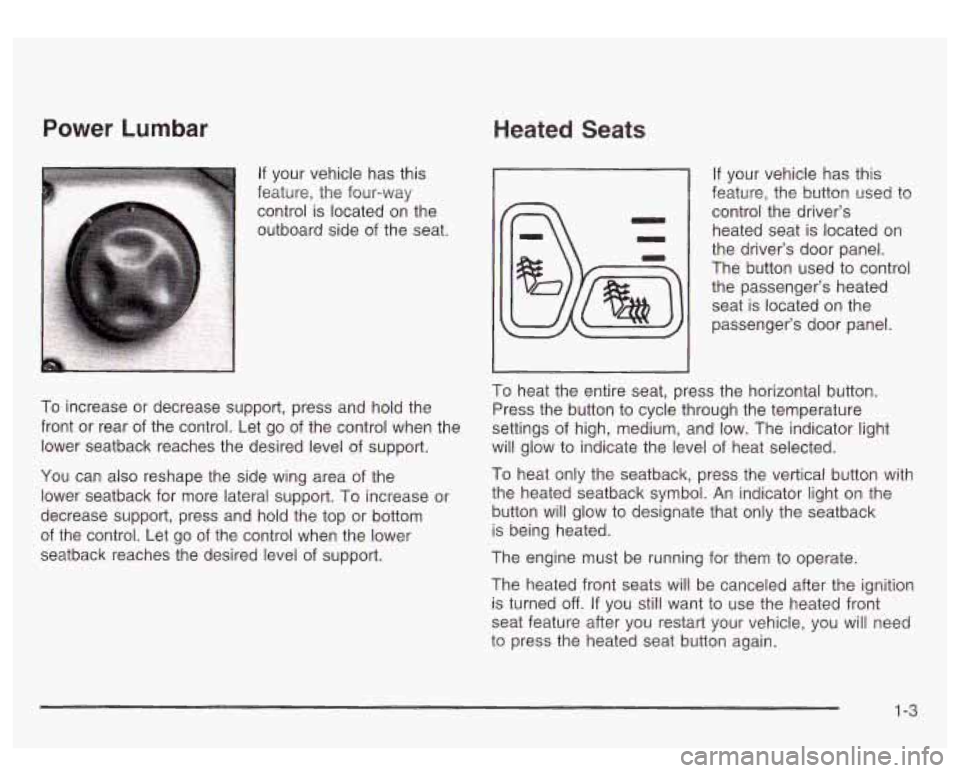
Power Lumbar
, If your vehicle has this
’ feature, the four-way
control is located on the
To increase or decrease support, press and hold the
front or rear of the control. Let go of the control when the
lower seatback reaches the desired level
of support.
You can also reshape the side wing area of the
lower seatback for more lateral support. To increase or
decrease support, press and hold the top or bottom
of the control. Let go of the control when the lower
seatback reaches the desired level of support.
Heated Seats
1
If your vehicle has this
feature, the button used to
control the driver’s heated seat
is located on
the driver’s door panel.
The button used to control
the passenger’s heated
seat is located on the
passenger’s door panel.
To heat the entire seat, press the horizontal button.
Press the button to cycle through the temperature
settings of high, medium, and low. The indicator light
will glow to indicate the level of heat selected.
To heat only the seatback, press the vertical button with
the heated seatback symbol. An indicator light
on the
button will glow to designate that only the seatback
is being heated.
The engine must be running for them to operate.
The heated front seats will be canceled after the ignition
is turned
off. If you still want to use the heated front
seat feature after
you restart your vehicle, you will need
to press the heated seat button again.
1-3
Page 14 of 428
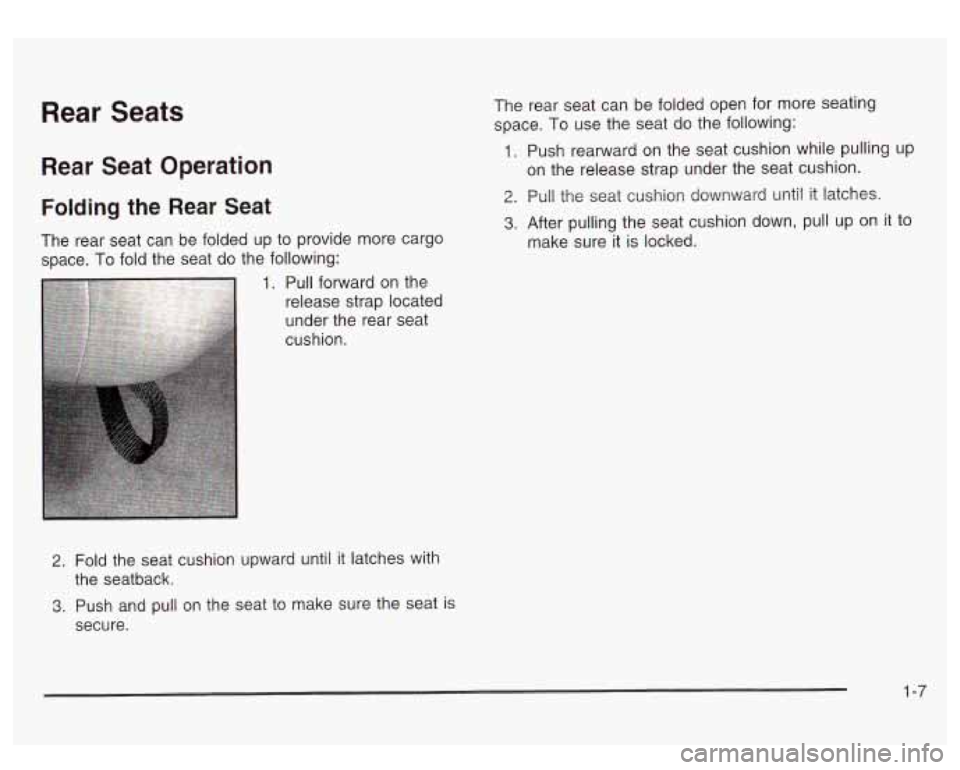
Rear Seats
Rear Seat Operation
Folding the Rear Seat
The rear seat can be folded up to provide more cargo
space. To fold the seat do the following:
2. Fold the seat cushion upward until it latches with
3. Push and pull on the seat to make sure the seat is
the seatback.
secure. The
rear seat can be folded open for more seating
space. To use the seat do the following:
1. Push rearward on the seat cushion while pulling up
on the release strap under the seat cushion.
2. Pull the seat cushion downward until it latches.
3. After pulling the seat cushion down, pull up on it to
make sure it is locked.
1 -7
Page 15 of 428
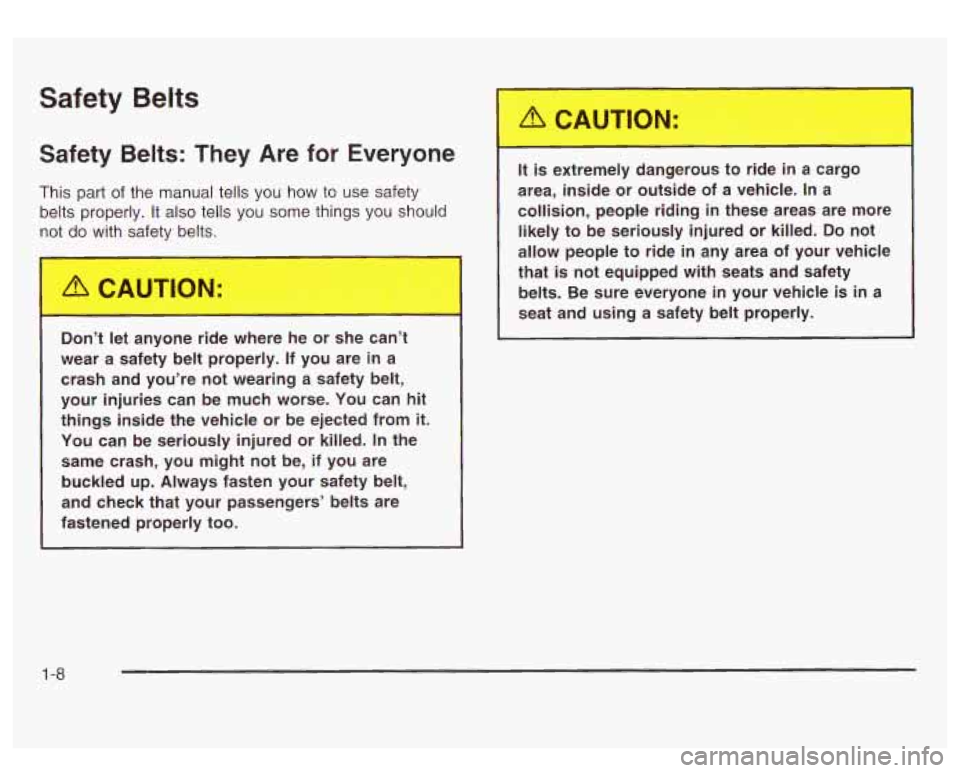
Safety Belts
Safety Belts: They Are for Everyone
This part of the manual tells you how to use safety
belts properly. It also tells you some things you should
not
do with safety belts.
.
Don’t let anyone ride __. ]ere he or she can’t
wear a safety belt properly. If you are in a
crash and you’re not wearing a safety belt,
your injuries can be much worse. You can hit things inside the vehicle or be ejected from
it.
You can be seriously injured or killed. In the
same crash, you might not be, if you are
buckled up. Always fasten your safety belt,
and check that your passengers’ belts are
fastened properly too.
It is extremely dangerous to ride in a cargo
area, inside or outside of a vehicle. In a
collision, people riding in these areas are more
likely to be seriously injured or killed.
Do not
allow people
to ride in any area of your vehicle
that is not equipped with seats and safety
belts. Be sure everyone in your vehicle
is in a
seat and using a safety belt properly.
1 -8
Page 20 of 428
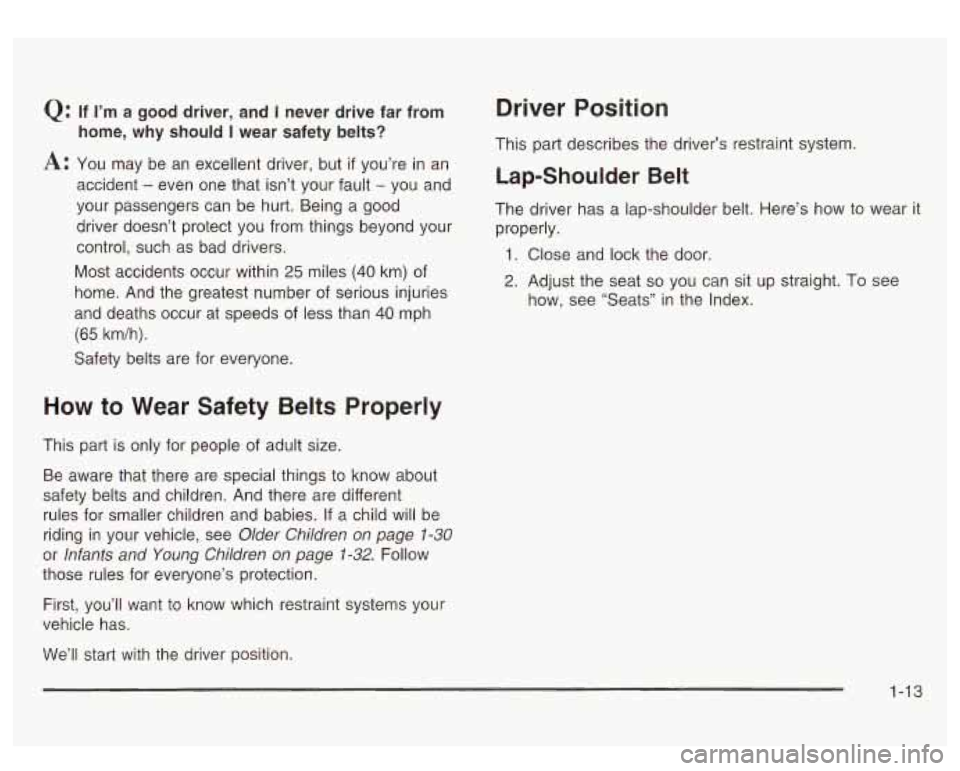
Q:
A:
If I’m a good driver, and I never drive far from
home, why should
I wear safety belts?
You may be an excellent driver, but
if you’re in an
accident
- even one that isn’t your fault - you and
your passengers can be hurt. Being a good
driver doesn’t protect you from things beyond your
control, such as bad drivers.
Most accidents occur within
25 miles (40 km) of
home. And the greatest number of serious injuries
and deaths occur at speeds of less than
40 mph
(65 km/h).
Safety belts are for everyone.
How to Wear Safety Belts Properly
This part is only for people of adult size.
Be aware that there are special things to know about
safety belts and children. And there are different
rules for smaller children and babies. If a child will be
riding in your vehicle, see
Older Children on page 1-30
or lnfants and Young Children on page 1-32. Follow
those rules for everyone’s protection.
First, you’ll want to know which restraint systems your
vehicle has.
Driver Position
This part describes the driver’s restraint system.
Lap-Shoulder Belt
The driver has a lap-shoulder belt. Here’s how to wear it
properly.
1. Close and lock the door.
2. Adjust the seat so you can sit up straight. To see
how, see “Seats’’ in the Index.
We’ll start with the driver position.
1-13
Page 34 of 428
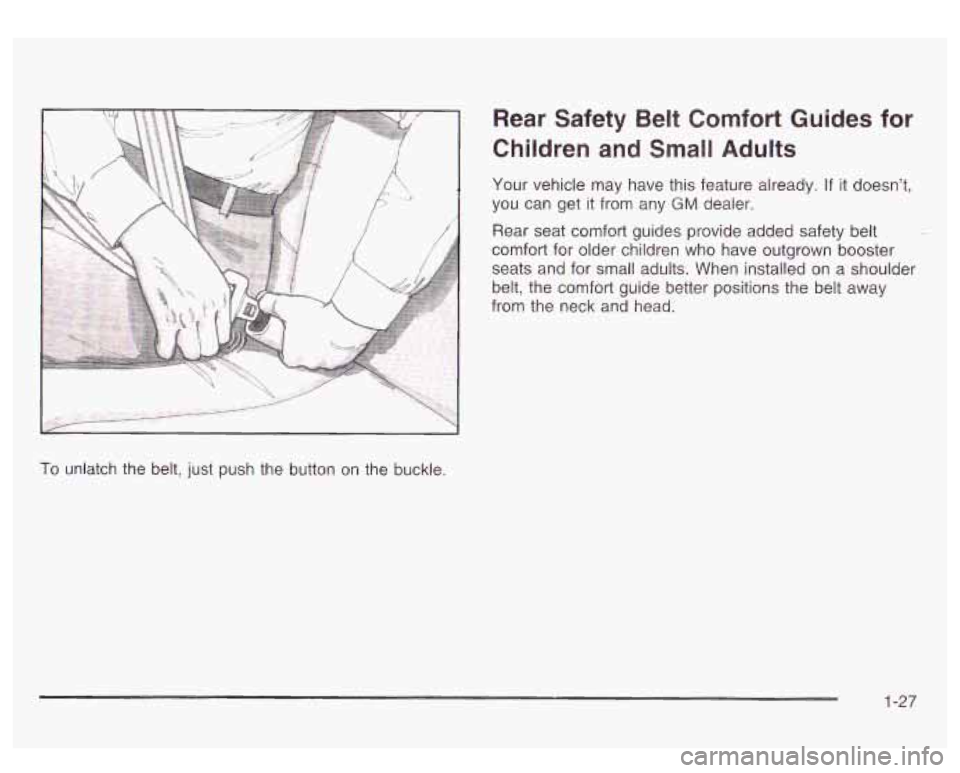
Rear Safety Belt Comfort Guides for
Children and Small Adults
Your vehicle may have this feature already. If it doesn't,
you can get it from any
GM dealer.
Rear seat comfort guides provide added safety belt
comfort for older children who have outgrown booster
seats and for small adults. When installed on a shoulder
belt, the comfort guide better positions the belt away
from the neck and head.
To unlatch the belt, just push the button on the buckle.
1-27
Page 37 of 428
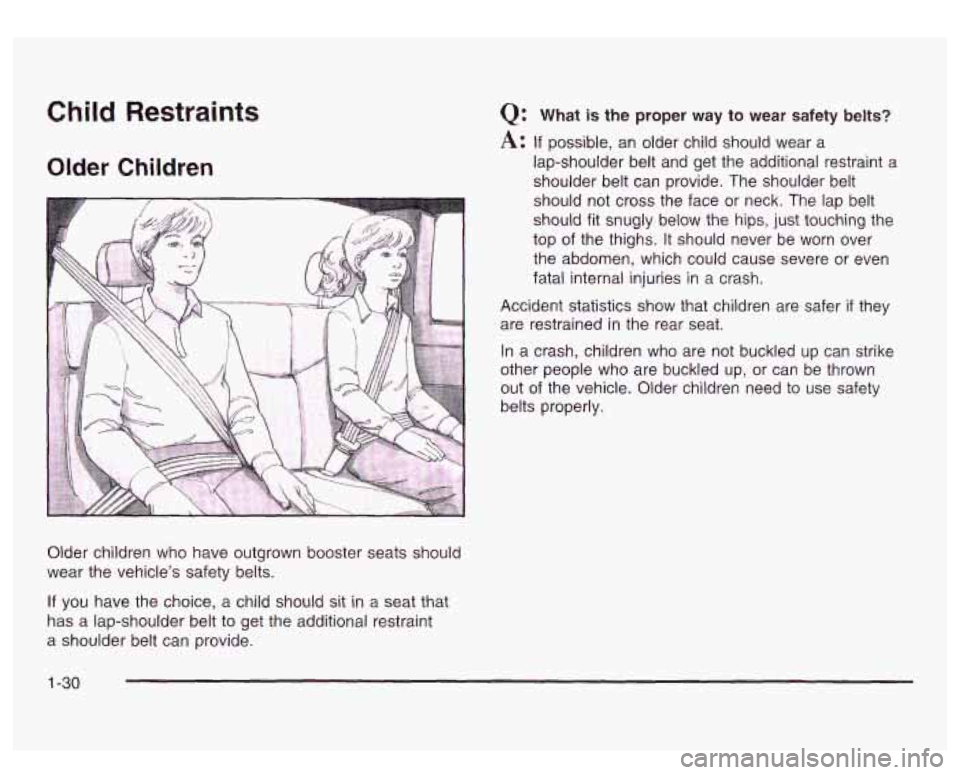
Accident statistics show that children are safer if they
are restrained in the rear seat.
In a crash, children who are not buckled up can strike
other people who are buckled up, or can be thrown
out of the vehicle. Older children need to use safety
belts properly.
Child Restraints
Older Children
Q:
A:
Older children who have outgrown booster seats should
wear the vehicle’s safety belts. What
is the proper
way to wear safety belts?
If possible, an older child should wear a
lap-shoulder belt and get the additional restraint a
shoulder belt can provide. The shoulder belt
should not cross the face or neck. The lap belt
should
fit snugly below the hips, just touching the
top of the thighs.
It should never be worn over
the abdomen, which could cause severe or even
fatal internal injuries in
a crash.
If you have the choice, a child should sit in a seat that
has a lap-shoulder belt to get the additional restraint
a shoulder belt can provide.
1-30